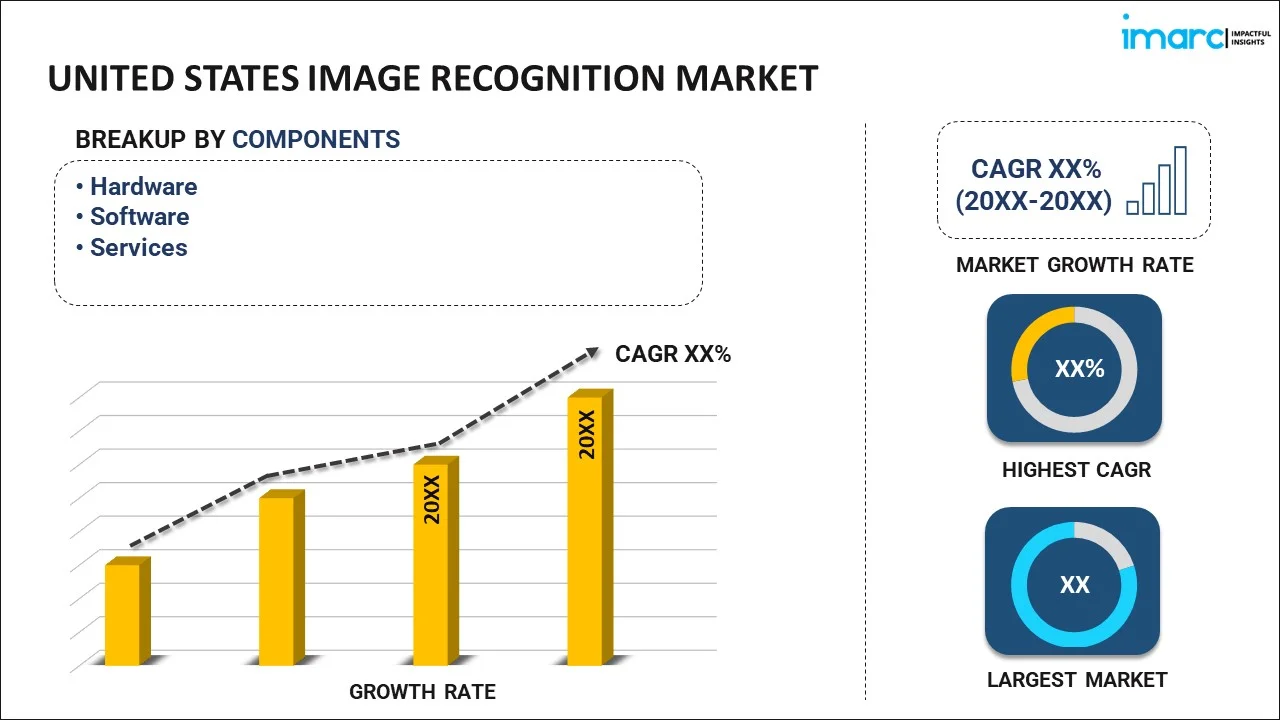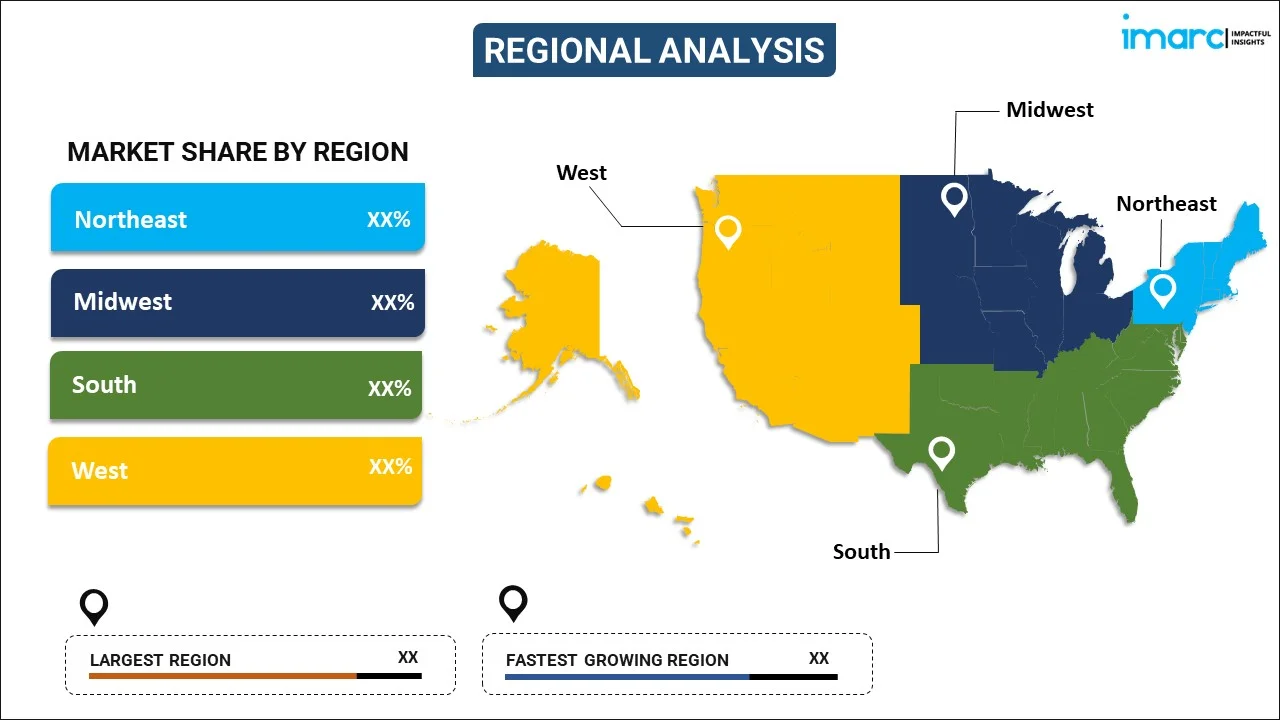
United States Image Recognition Market Report by Component (Hardware, Software, Services), Technology (Object Detection, QR/Barcode Recognition, Facial Recognition, Pattern Recognition, Optical Character Recognition, and Others), Application (Scanning and Imaging, Security and Surveillance, Image Searching, Augmented Reality, Marketing and Advertising, and Others), Deployment Type (On-premises, Cloud-based), End Use Industry (BFSI, Media and Entertainment, IT and Telecom, Government, Healthcare, Transportation and Logistics, and Others), and Region 2025-2033
Market Overview:
United States image recognition market size reached USD 10.1 Billion in 2024. Looking forward, IMARC Group expects the market to reach USD 20.5 Billion by 2033, exhibiting a growth rate (CAGR) of 8.1% during 2025-2033. The increasing development of sophisticated algorithms, particularly deep learning models, which has significantly improved the accuracy and performance of image recognition systems, is driving the market.
|
Report Attribute
|
Key Statistics
|
|---|---|
|
Base Year
|
2024
|
|
Forecast Years
|
2025-2033
|
|
Historical Years
|
2019-2024
|
|
Market Size in 2024
|
USD 10.1 Billion |
|
Market Forecast in 2033
|
USD 20.5 Billion |
| Market Growth Rate 2025-2033 | 8.1% |
Image recognition, also known as computer vision, is a field of artificial intelligence (AI) focused on enabling machines to interpret and understand visual information from images or videos. It involves developing algorithms and models that can analyze and identify patterns, objects, or features within digital images. Image recognition has diverse applications, ranging from facial recognition and object detection to medical image analysis and autonomous vehicles. The process typically involves training a model on large datasets and teaching it to recognize specific patterns or objects. Convolutional neural networks (CNNs) are commonly used in image recognition tasks due to their ability to capture spatial hierarchies and learn relevant features. The goal is to enable machines to see and comprehend visual data, facilitating tasks such as image classification, object localization, and scene understanding. Advances in image recognition have significant implications for various industries, including healthcare, security, and automation, contributing to the development of more intelligent and capable technology.
United States Image Recognition Market Trends:
The image recognition market in the United States is experiencing robust growth, driven by several key factors. Firstly, the increasing integration of AI and machine learning (ML) technologies across industries has propelled the demand for advanced image recognition solutions. These technologies enhance the accuracy and efficiency of image analysis, catering to diverse applications such as healthcare diagnostics, retail analytics, and autonomous vehicles. Moreover, the escalating adoption of smartphones equipped with high-quality cameras has generated a massive influx of image data. This influx has spurred the need for sophisticated image recognition algorithms capable of extracting meaningful insights from vast datasets. Concurrently, the rise of e-commerce and the imperative for personalized customer experiences have intensified the deployment of image recognition in product recommendation systems and virtual try-on services, thereby fueling market growth. Furthermore, the heightened focus on security and surveillance in both public and private sectors has accelerated the demand for advanced image recognition in facial recognition systems and object detection. Besides this, the intersection of image recognition with augmented reality (AR) and virtual reality (VR) applications, which enhance user experiences in gaming, education, and training simulations, is expected to drive the market in the United States during the forecast period.
United States Image Recognition Market Segmentation:
IMARC Group provides an analysis of the key trends in each segment of the market, along with forecasts at the country level for 2025-2033. Our report has categorized the market based on component, technology, application, deployment type, and end use industry.
Component Insights:

- Hardware
- Software
- Services
The report has provided a detailed breakup and analysis of the market based on the component. This includes hardware, software, and services.
Technology Insights:
- Object Detection
- QR/Barcode Recognition
- Facial Recognition
- Pattern Recognition
- Optical Character Recognition
- Others
A detailed breakup and analysis of the market based on technology have also been provided in the report. This includes object detection, QR/barcode recognition, facial recognition, pattern recognition, optical character recognition, and others.
Application Insights:
- Scanning and Imaging
- Security and Surveillance
- Image Searching
- Augmented Reality
- Marketing and Advertising
- Others
The report has provided a detailed breakup and analysis of the market based on the application. This includes scanning and imaging, security and surveillance, image searching, augmented reality, marketing and advertising, and others.
Deployment Type Insights:
- On-premises
- Cloud-based
A detailed breakup and analysis of the market based on deployment type have also been provided in the report. This includes on-premises and cloud-based.
End Use Industry Insights:
- BFSI
- Media and Entertainment
- IT and Telecom
- Government
- Healthcare
- Transportation and Logistics
- Others
The report has provided a detailed breakup and analysis of the market based on the end use industry. This includes BFSI, media and entertainment, IT and telecom, government, healthcare, transportation and logistics, and others.
Regional Insights:

- Northeast
- Midwest
- South
- West
The report has also provided a comprehensive analysis of all the major regional markets, which include the Northeast, Midwest, South, and West.
Competitive Landscape:
The market research report has also provided a comprehensive analysis of the competitive landscape in the market. Competitive analysis such as market structure, key player positioning, top winning strategies, competitive dashboard, and company evaluation quadrant has been covered in the report. Also, detailed profiles of all major companies have been provided.
United States Image Recognition Market Report Coverage:
| Report Features | Details |
|---|---|
| Base Year of the Analysis | 2024 |
| Historical Period | 2019-2024 |
| Forecast Period | 2025-2033 |
| Units | Billion USD |
| Scope of the Report | Exploration of Historical and Forecast Trends, Industry Catalysts and Challenges, Segment-Wise Historical and Predictive Market Assessment:
|
| Components Covered | Hardware, Software, Services |
| Technologies Covered | Object Detection, QR/Barcode Recognition, Facial Recognition, Pattern Recognition, Optical Character Recognition, Others |
| Applications Covered | Scanning and Imaging, Security and Surveillance, Image Searching, Augmented Reality, Marketing and Advertising, Others |
| Deployment Types Covered | On-premises, Cloud-based |
| End Use Industries Covered | BFSI, Media and Entertainment, IT and Telecom, Government, Healthcare, Transportation and Logistics, Others |
| Regions Covered | Northeast, Midwest, South, West |
| Customization Scope | 10% Free Customization |
| Post-Sale Analyst Support | 10-12 Weeks |
| Delivery Format | PDF and Excel through Email (We can also provide the editable version of the report in PPT/Word format on special request) |
Key Questions Answered in This Report:
- How has the United States image recognition market performed so far and how will it perform in the coming years?
- What has been the impact of COVID-19 on the United States image recognition market?
- What is the breakup of the United States image recognition market on the basis of component?
- What is the breakup of the United States image recognition market on the basis of technology?
- What is the breakup of the United States image recognition market on the basis of application?
- What is the breakup of the United States image recognition market on the basis of deployment type?
- What is the breakup of the United States image recognition market on the basis of end use industry?
- What are the various stages in the value chain of the United States image recognition market?
- What are the key driving factors and challenges in the United States image recognition?
- What is the structure of the United States image recognition market and who are the key players?
- What is the degree of competition in the United States image recognition market?
Key Benefits for Stakeholders:
- IMARC’s industry report offers a comprehensive quantitative analysis of various market segments, historical and current market trends, market forecasts, and dynamics of the United States image recognition market from 2019-2033.
- The research report provides the latest information on the market drivers, challenges, and opportunities in the United States image recognition market.
- Porter's five forces analysis assist stakeholders in assessing the impact of new entrants, competitive rivalry, supplier power, buyer power, and the threat of substitution. It helps stakeholders to analyze the level of competition within the United States image recognition industry and its attractiveness.
- A competitive landscape allows stakeholders to understand their competitive environment and provides an insight into the current positions of key players in the market.
Need more help?
- Speak to our experienced analysts for insights on the current market scenarios.
- Include additional segments and countries to customize the report as per your requirement.
- Gain an unparalleled competitive advantage in your domain by understanding how to utilize the report and positively impacting your operations and revenue.
- For further assistance, please connect with our analysts.
 Inquire Before Buying
Inquire Before Buying
 Speak to an Analyst
Speak to an Analyst
 Request Brochure
Request Brochure
 Request Customization
Request Customization




.webp)




.webp)












